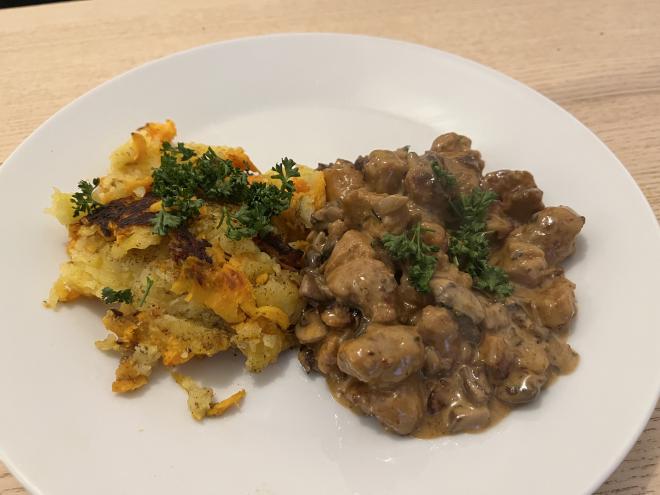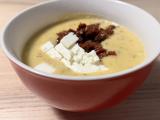- Climate-Friendly Cooking :carrot: /
- Recipes/
- Vegetarian Zürcher Geschnetzeltes with Hash Browns (Sliced Meat Zurich Style, without the, you know, Meat)/
Vegetarian Zürcher Geschnetzeltes with Hash Browns (Sliced Meat Zurich Style, without the, you know, Meat)
Table of Contents
Jump to Recipe
Jump to Carbon Footprint
Zürcher Geschnetzeltes is a classic dish in Switzerland: traditionally it consists of sliced and sautéed veal in a mushroom and cream sauce, often with a little white wine to add a subtle acidity.
Over time, however, there have been many variations, sometimes with additional ingredients, with a variety of side dishes and often with other meats, then served as “Geschnetzeltes Zürcher Art”. It is therefore a very versatile dish and it is not difficult to make a vegetarian version - in my case with coarse soy slices that are simply soaked in vegetable stock before cooking.

There are two tricks to making the perfect sauce:
- First, fry the soy slices in a pan and then make the sauce in the same pan: this will give your sauce some subtle roasted flavours from the frying process.
- Use a little tomato paste and a pinch of smoked paprika. The dish should not taste of tomato or paprika, but frying the tomato puree will add more roasted flavours and a subtle sweet note. The smoked paprika also adds to the flavour.
A classic accompaniment to Zürcher Geschnetzeltes is rösti (hash browns), but it can also be served with pasta or spaetzle.
The recipe is based on the one from Cookinesi
Recipe #
Vegetarian Zürcher Geschnetzeltes
60 minutes
2 portions
Ingredients #
For the Zürcher Geschnetzeltes
- 2 tablespoons vegetable stock powder
- 150 g coarse soy shreds
- 1 onion
- 250 g mushrooms
- 2 tablespoons sunflower seed oil
- 25 g butter
- 1 tablespoon tomato puree
- 125 g white wine
- 175 g cream
- 1 pinch of paprika powder
- 1 pinch of salt
- 1 pinch of pepper
For the rösti / hash browns
- 350 g potatoes (raw or pre-cooked)
- 2 tablespoons oil
- 1 pinch of salt
- 1 pinch of pepper
Directions #
- Bring the water to the boil. Add the vegetable stock powder and soak the soy shreds in the stock according to the instructions on the packet (about 15 minutes).
- Meanwhile, peel and chop the onion. Wash and rinse the mushrooms and cut into large cubes. (They will continue to lose water while frying).
- Heat the sunflower oil in a frying pan and fry the soaked soya cutlets well. Remove from the pan and set aside.
- Heat the butter in the same frying pan and sauté the onions, then add the mushrooms and sauté.
- Add the tomato purée to the pan with the onions and mushrooms, fry briefly, then deglaze with the white wine and reduce slightly. Add the cream, paprika powder, salt and pepper and continue to reduce over a low heat.
- Prepare the hash browns at the same time: Peel the potatoes and grate them finely on a square grater. Fry in batches in a pan with a little oil. Season with salt and pepper, then carefully turn and fry on the second side for a total of 10-15 minutes per rösti.
- Serve the hash browns with the sliced meat.
Carbon Footprint #
In total, two servings of vegetarian Zürcher Geschnetzeltes with rösti have an estimated carbon footprint of 1926 g
This ranks it number 40 out of 57 recipes published on the blog so far in terms of estimated carbon footprint.
It therefore belongs to the tertile of recipes with the highest emissions (bottom 33%). 😮When it comes to the individual ingredients, the cream stands out: Almost 40% of the recipe’s greenhouse gas emissions come from it, although it only accounts for around 14% of the ingredients’ weight. This is, of course, due to cattle farming, which produces a relatively large amount of methane. If the cream were replaced with vegan oat cream, the whole recipe would have a better balance of 630g CO2 equivalent - a 32% reduction for the whole recipe. For comparison: According to IFEU, oat cream has a carbon footprint of 0.6, while conventional cream made from cow’s milk has a carbon footprint of 4.2 (source, both figures refer to kg of CO2 equivalents per kg of food).
Rösti, on the other hand, has a very good carbon footprint thanks to the potatoes: potatoes account for almost 30% of the weight of the ingredients, but only about 4% of the climate impact of the dish.
| ingredient | carbon footprint per kg | carbon footprint (in g) for 2 servings | % of ingredients | % of CO2 emissions |
|---|---|---|---|---|
| Vegetable stock | 0.3 | 5 | 1% | 0% |
| Soy shreds | 1.0 | 150 | 12% | 8% |
| Onion | 0.2 | 16 | 7% | 1% |
| Mushrooms | 1.3 | 325 | 20% | 17% |
| Oil | 3.3 | 66 | 2% | 3% |
| Butter | 9.0 | 225 | 2% | 12% |
| Tomato paste | 4.3 | 43 | 1% | 2% |
| White wine | 1.0 | 125 | 10% | 6% |
| cream | 4.2 | 735 | 14% | 38% |
| Paprika powder | 1.1 | 2 | 0% | 0% |
| Salt | 0.7 | 1 | 0% | 0% |
| Pepper | 1.2 | 1 | 0% | 0% |
| Potatoes | 0.2 | 70 | 29% | 4% |
| Oil | 3.3 | 66 | 2% | 3% |
| Salt | 0.7 | 1 | 0% | 0% |
| Pepper | 1.2 | 1 | 0% | 0% |
| Fry sliced meat | 77 | 4% | ||
| Fry rösti | 17 | 1% |


